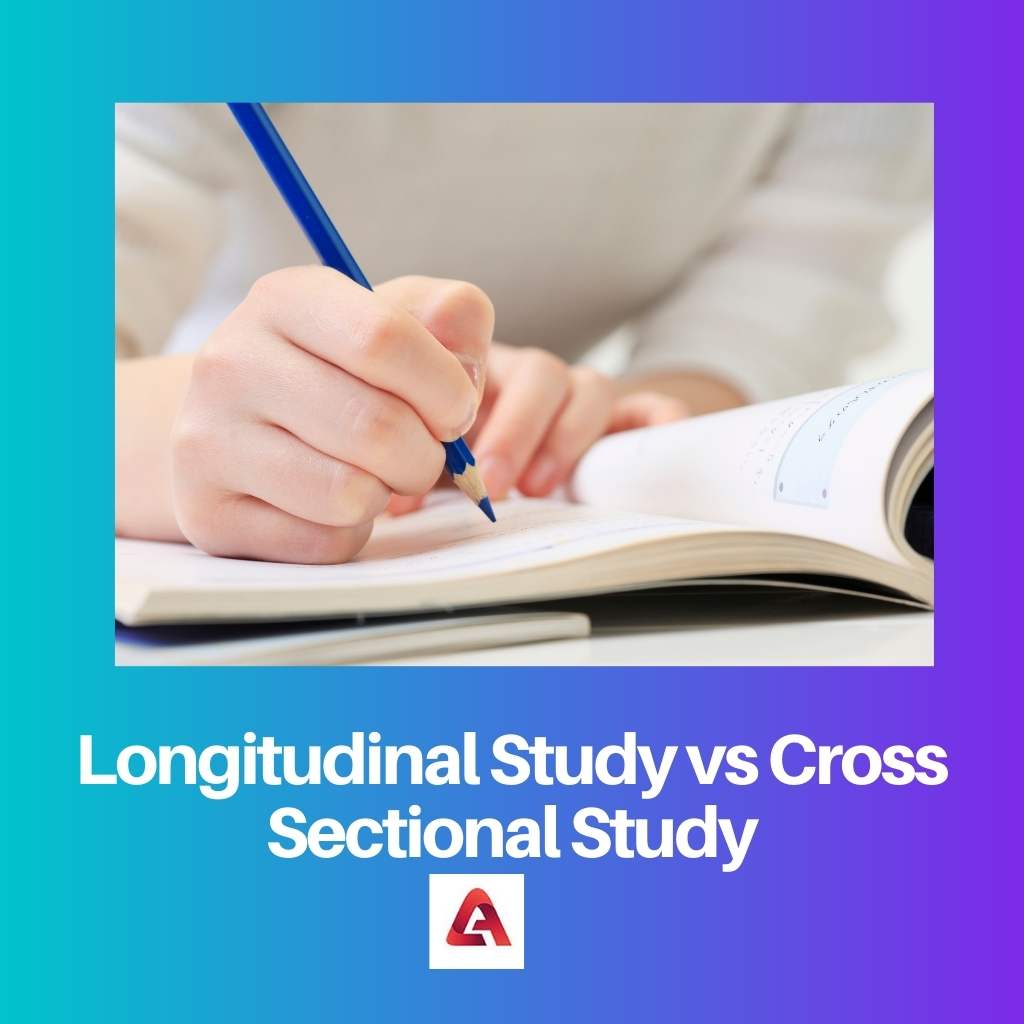Surveys and studies help us form a hypothesis or theory, or even a strategy. Study as many tools to suit the aim of the observation. Different types of studies are able to present different aspects of analyse.
Longitudinal study and cross-sectional study are two examples of observational studies.
Key Takeaways
- A longitudinal study follows a group of subjects over an extended period, while a cross-sectional study looks at a group of subjects at a specific time.
- A longitudinal study can measure changes over time, while a cross-sectional study can only measure differences between groups at a specific time.
- A longitudinal study is more time-consuming and expensive than a cross-sectional study.
Longitudinal Study vs Cross Sectional Study
A longitudinal study is a type of study where a specific topic is repeatedly examined to check the changes that occur over a period. A cross-sectional study is a study that involves collecting data from different people at a specific time to observe it. It studies the factors of a population.

A longitudinal study is a study that concentrates on one single sample and observes it repetitively to track the change. It is not restricted to time. This survey turns out to be costly to pursue.
It is used to notice the rate and reason for any developments or regression of something.
A cross-sectional study is like a survey in which lots of data is collected and then observed to get a conclusion. It is limited to only one time, and it can not provide any information beyond that.
This can be done in a short time and without spending much money.
Comparison Table
| Parameters of Comparison | Longitudinal Study | Cross Sectional Study |
|---|---|---|
| Definition | It is a study where one particular topic becomes the subject of repetitive examination to observe the changes over a period of time. | In this study data from different people is collected at a specific time to observe. |
| Time frame | In this study, samples are observed repetitively over a period of time. | In this study, the samples are observed at a specific point in time. |
| Samples | The samples for observation remains the same. | Different samples are subjected to observation. |
| Expense | This type of study is expensive. | This type of study is not very expensive. |
| Cause and effect | The relationship between cause and effect can be known through this study. | This type of study can not determine the relationship between cause and effect. |
| Time consumption | This study takes lots of time. | This study is not very time-consuming. |
What is Longitudinal Study?
A longitudinal study is a type of research that has been structured to observe a particular thing and observe the changes that take place over time. This also helps in experiments.
One single sample becomes the point of observation repetitively. Day-to-day variation in behaviours, thoughts, and even emotions can be observed by using this study.
The longitudinal study can be utilised in various fields such as economics, epidemiology, sociology, geography, and even medicine.
As this type of study is not restricted to one time, the changes, the improvements, developments, everything can be detected. It is a time-consuming process and also expensive to some extent. And these can be marked as the disadvantages of this study.
Remarkable insights can be derived from this study. It gives the vivid relationship between cause and effect. Any event that is associated with growth or transition can be a subject of this type of study.
This study can take place with a small sample, and the survey results are competent enough to make an impact.

What is Short Cross Sectional Study?
To conduct a cross-sectional study, data is collected from different people. This study is limited to a specific point in time. The researcher observes the collected data and evaluates it to reach a conclusion.
This consists of the general data of the people, and thus the researcher can study the factors of the population and society at that very time.
This study does not consume much time, and it does not cost much money as well. With the data, a researcher can measure the probable outcome. A lot of data gets collected in this study with which many variables can get compared.
This study can not determine the cause-and-effect relationships, and it is also unable to deliver any definite information as it is restricted to one time and can not say anything about before and after of that time.

Main Differences Between Longitudinal and Cross Sectional Study
- A longitudinal study is a type of study where one particular topic or subject becomes the centre of repetitive examination over a period of time and is a cross-sectional study. The collection of data from different people takes place, which gets an observed study at one specific time.
- A longitudinal study happens over a period of time, whereas a cross-sectional study happens at one particular time.
- The subject of each longitudinal study is fixed, while the time of each cross-sectional study is fixed.
- A longitudinal study is proved to be expensive, but a cross-sectional study is pocket friendly. It does not cost much.
- A longitudinal study gives accounts of changes in details over time, whereas a cross-sectional study shows generalized public opinion.
- In a longitudinal study, a small amount of data is enough, but in a cross-sectional study the higher amount of data is collected.


The detailed delineation of longitudinal and cross-sectional studies in the article contributes to an enhanced understanding of their respective characteristics and utilities in research settings. The pragmatic examples elucidate the practical applications of these studies effectively.
I share your perspective. The article provides a comprehensive overview of longitudinal and cross-sectional studies, making it a valuable resource for research professionals and scholars alike.
I concur with your assessment. The article’s meticulous exploration of longitudinal and cross-sectional studies is invaluable for researchers seeking to comprehend their differential implications in diverse contexts.
The article provides a thorough comparison of longitudinal and cross-sectional studies, elucidating their distinct attributes and utilities in research. The real-life examples further enhance the clarity of the content.
Agreed. The article excels in delineating the fundamental disparities between longitudinal and cross-sectional studies, enriching the understanding of their significance in varied domains.
I second your thoughts, the article furnishes an insightful analysis of these studies, making it easier to discern their respective roles in research.
The article effectively highlights the distinctions between longitudinal and cross-sectional studies, shedding light on their unique features and applications in research.
I concur, the article serves as a valuable resource for understanding the nuances of observational studies and their implications in research.
The article does a great job of explaining the differences between longitudinal and cross-sectional studies. I appreciate the detail and the examples given to illustrate each type of study.
Absolutely, the comparison table is especially helpful in highlighting the contrasts between the two types of studies.
I agree, the article is very informative and provides a clear understanding of both types of studies.
The exhaustive comparison between longitudinal and cross-sectional studies in the article is commendable, offering comprehensive insights into their distinct characteristics. The lucid explanations aid in elucidating the complexities of observational studies.
Absolutely, the article’s informative content serves as a significant reference for understanding the fundamental disparities between longitudinal and cross-sectional studies.
I completely agree with your assessment. The article meticulously examines the nuances of both types of studies and provides an invaluable resource for research practitioners.
The article presents a comprehensive overview of longitudinal and cross-sectional studies, emphasizing the significance of each in various fields. It effectively points out the strengths and limitations of both types of studies.
I agree, the article offers valuable insights into the applications of each type of study across different disciplines.
The comparisons between longitudinal and cross-sectional studies are well-articulated, providing a clear understanding of their differences and uses.
The comparison table provides a clear and concise summary of the disparities between longitudinal and cross-sectional studies, offering a comprehensive perspective on their characteristics and implications.
The detailed explanations and examples in the article facilitate an enhanced understanding of the complexities involved in longitudinal and cross-sectional studies.
I couldn’t agree more, the article effectively outlines the key differences between these two types of studies, aiding in better comprehension.
The article offers a comprehensive comparison of longitudinal and cross-sectional studies, presenting their distinct functionalities and implications with clarity. The practical applications outlined in the article further strengthen its informational value.
I share your sentiments. The article adeptly dissects the intricacies of both types of studies, elucidating their unique contributions to research practices.
The article provides an in-depth contrast of longitudinal and cross-sectional studies, expounding upon their individual attributes and relevance in the realm of research. The nuances highlighted in the article significantly enhance the understanding of these studies.
The article convincingly elucidates the disparities between longitudinal and cross-sectional studies, effectively highlighting the diverse nuances of these observational research methods. The exhaustive details enrich the comprehension of their contrasting functionalities.
Absolutely, the article’s detailed examination of longitudinal and cross-sectional studies benefits readers by elucidating the fundamental distinctions between these two pivotal research practices.
I resonate with your viewpoint. The article’s comprehensive analysis of longitudinal and cross-sectional studies is instrumental in deepening the understanding of these crucial research methodologies.